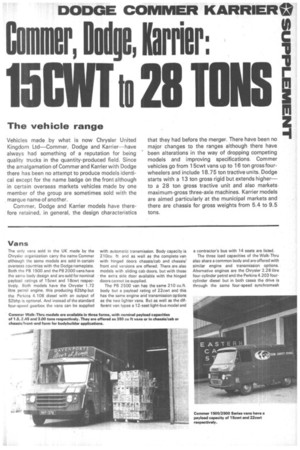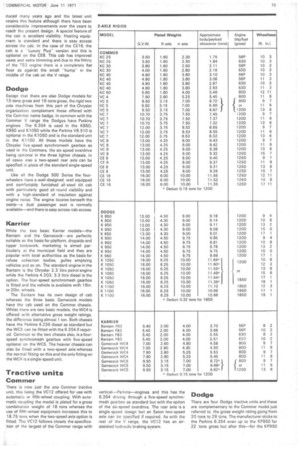Vans
Page 73

Page 74

Page 75

Page 76

If you've noticed an error in this article please click here to report it so we can fix it.
The only vans sold in the UK made by the Chrysler organization carry the name Commer although the same models are sold in certain overseas countries with the Dodge nameplate. Both the PB 1500 and the PB 2000 vans have the same body design and are sold for nominal payload ratings of 15cwt and 18cwt respectively. Both models have the Chrysler 1.72 litre petrol engine, this producing 62bhp but the Perkins 4.108 diesel with an output of 52bhp is optional. And instead of the standard four-speed gearbox the vans can be supplied with automatic transmission. Body capacity is 210cu. ft. and as well as the complete van with hinged doors chassis/cab and chassis/ front end versons are offered. There are also models with sliding cab doors, but with these the extra side door available with the hinged doors cannot be supplied.
The PB 2500 van has the same 210 cu.ft. body but a payload rating of 22cwt and this has the same engine and transmission options as the two lighter vans. But as well as the different van types a 12-seat light-bus model and a contractor's bus with 14 seats are listed.
The three load capacities of the Walk-Thru also share a common body and are offered with similar engine and transmission options. Alternative engines are the Chrysler 2.26 litre four-cylinder petrol and the Perkins 4.203 fourcylinder diesel but in both cases the drive is through the same four-speed synchromesh
In gearbox. Most other parts of the mechanical
specifications vary according to model and this
1 WZapplies particularly to the rear axle, suspension and the brakes. As with the lighter vans chassis/ cab and chassis/front end versions of the Walk-Thru models are available but there is only one layout of doors-sliding doors at the front and hinged doors at the rear-although the van can be supplied without the rear doors. Two-axle rigids
• jCommer
IIThe three Commer Walk-Thru van models are also marketed as chassis cabs so • it is logical that they should be in this section; as well as the KC25, 30 and 40 there is in addition a KC60 which comes only as a chassis cab. In 2 the tables, the gross output of the engine is shown, as compared with the net rating in the van table; their engines are exactly the same. In (1) addition to the wheelbase as for the van, the
KC40 comes with a longer wheelbase of lift
3ins as a chassis/cab if required. The KC60 has a longer wheelbase still of 12ft 11 in, this chassis having a Perkins 4.236 diesel and being designed for nominal payload rating of 3-tons. When sold as chassis cabs the WalkThru has folding side doors and the KC60 can be purchased as a chassis/scuttle or chassis/ front end.
It will be seen that the Commer two axle rigid vehicle range can be divided into two distinct categories-the V range and the C range. Where the designation 'V' is used this denotes a vertical engine which is a Perkins 4,236 or a Perkins 6.354. When it comes to the 'C designations these have the well-known 1S3 three-cylinder opposed-piston diesel. The designations also give a rough idea of the payload capacity for which the model is designed except that for the heaviest vehicle in the range-the CE16-this signifies maximum gross weight rating. Fourfiveand six-speed synchromesh gearboxes are used in the Commer range, the actual type available depending on the model although there is usually at least one option. All chassis have air-assisted-hydraulic two-line braking systems except for the 0E16 which has a full air system with separate lines for the front and rear axle.
A common feature on all the Commer rigids is an all-steel cab of attractive styling and with spacious interior. Commers were the first goods vehicles to have a forward control cab with no engine protrusion. The first was intro
duced many years ago and the latest unit retains this feature although there have been considerable improvements over the years to reach the present design. A special feature of the cab is excellent visibility. Heating equipment is standard and there is easy access across the cab. In the case of the CE16, the cab is a -Luxury Plus" version and this is optional on the CE8. This cab has improved seats and extra trimming and due to the fitting of the TS3 engine there is a completely flat floor as against the small "'hump" in the middle of the cab on the V range.
Dodge
Except that there are also Dodge models for 13-tons gross and 16-tons gross, the rigid two axle machines from this part of the Chrysler organization complement those offered with the Commer name badge. In common with the Commer V range the Dodges have Perkins engines. The 6.354 is used in the K850, K950 and K1050 while the Perkins V8.510 is optional in the K1050 and is the standard unit in the K1100. All these models have the Chrysler five-speed synchromesh gearbox as used in the Commers, the six-speed overdrive being optional in the three lighter chassis. In all cases also a two-speed rear axle can be specified in place of the standard single-speed unit.
Like all the Dodge 500 Series the fourwheelers have a well-designed, well equipped and comfortably furnished all-steel tilt cab with particularly good all-round visibility and with a high-standard of insulation against engine noise. The engine locates beneath the seats-a dual passenger seat is normally available-and there is easy across-cab access.
Karrier
While thE two basic Karrier models-the Bantam and the Gamecock-are perfectly suitable as the basis for platform, dropside and tipper bodywork, marketing is aimed particularly at the municipal field and they are popular with local authorities as the basis for refuse collection bodies, gu Hey emptying vehicles and so on. The standard engine in the Bantam is the Chrysler 2.3 litre petrol engine while the Perkins 4.203, 3-3 litre diesel is the option. The four-speed synchromesh gearbox is fitted and the vehicle is available with 16in. or 20in. wheels.
The Bantam has its own design of cab whereas the three basic Gamecock models have the cab used on the Commer chassis. Whilst there are two basic models, the WC4 is offered with alternative gross weight ratings, the difference being almost 1 ton. Both chassis have the Perkins 4.236 diesel as standard but the WC5 can be fitted with the 6.354 if required. Common to the two chassis also, is a fourspeed synchromesh gearbox with five-speed optional on the WC5. The heavier chassis can also be fitted with a two-speed axle whereas the normal fitting on this and the only fitting on the WC4 is a single-speed unit.
Tractive units
Commer
There is now just the one Commer tractive unit, this being the VC12 offered for use with automatic or fifth-wheel coupling. With automatic coupling the model is plated for a gross combination weight of 18 tons whereas the use of fifth-wheel equipment increases this to 18.75 tons when the two-speed axle option is fitted. The VC12 follows closely the specification of the largest of the Commer range with
vertical-Perkins--engines and this has the 6.354 driving through a five-speed synchromesh gearbox as standard but with the option of the six-speed overdrive. The rear axle is a single-speed design but an Eaton two-speed axle can be specified if required. As with the rest of the V range, the VC12 has an airassisted hydraulic braking system. Dodge
There are four Dodge tractive units and these are complementary to the Commer model just referred to. the gross weight rating going from 20 tons to 28 tons. The manufacturer sticks to the Perkins 6.354 even up to the KP850 for 22 tons gross but after this-for the KP950
24-ton gross combination weight model and the KP1000 for 28 tons gross-the Perkins V8.510 is employed. All four tractive units have Eaton two-speed rear axles and synchromesh gearboxes with the five-speed standard in all cases and the six-speed-overdrive optional on the 28-ton gross machine.
Six-wheelers
Dodge
Although there are some Commer six-wheelers sold these are third-axle conversions by independent companies. Dodge is the only part of the Chrysler Group that markets factorybuilt six-wheelers, The KR in the chassis designation indicates single-drive rear bogie while the KT shows that the model has a doubledrive bogie. All these six-wheelers are plated for operation at 22 tons gross although the Outer axle spacing does not always allow this to be obtained: when this dimension is less than 18ft the limit of weight is 20 tons. Except for the rear bogies, the two basic types are identical mechanically and have the Perkins V8.510 diesel engine driving through a fivespeed synchromesh gearbox as standard with the six-speed overdrive the option. As with even the heaviest rigid chassis carrying the Dodge name, power steering is not standard on the 6 x 2 and 6x 4 models but it is an option.
In the case of the 6 x 2 there are two alternative two-speed Eaton driving axles, one giving a higher bogie load capacity than the other. The same thing applies in the case of the 6 x 4 when the rear bogie can be an Eaton 30 DT or an Eaton 38 DT, bogie capacities being 16 and 18 tons respectively. The trailing axle model has only one pair of springs-on the driving axle-the rearmost wheels being carried at the ends of pivoting links mounted in substantial trunnion members slung underneath the chassis. The forward ends of the links are connected to the rear ends of the main springs and this provides for the trailing wheels to be, in effect, independently suspended. The 6 x 4 chassis has Hendrickson two-spring suspension.


































































































































































